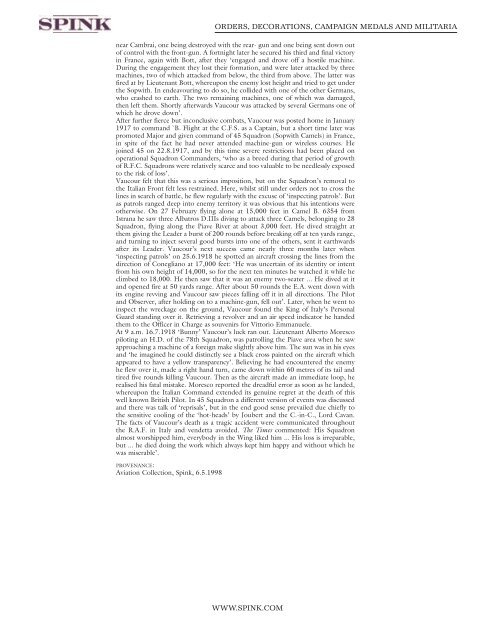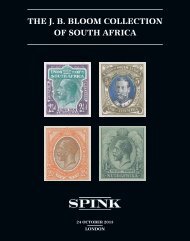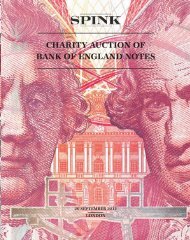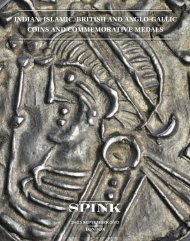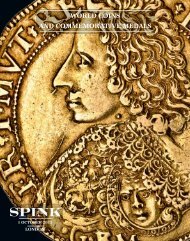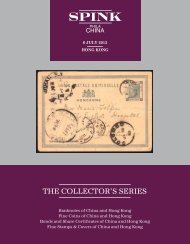orders, decorations, campaign medals and militaria - Spink
orders, decorations, campaign medals and militaria - Spink
orders, decorations, campaign medals and militaria - Spink
You also want an ePaper? Increase the reach of your titles
YUMPU automatically turns print PDFs into web optimized ePapers that Google loves.
<strong>orders</strong>, deCoratioNs, CampaigN medaLs aNd miLitaria<br />
near Cambrai, one being destroyed with the rear- gun <strong>and</strong> one being sent down out<br />
of control with the front-gun. A fortnight later he secured his third <strong>and</strong> final victory<br />
in France, again with Bott, after they ‘engaged <strong>and</strong> drove off a hostile machine.<br />
During the engagement they lost their formation, <strong>and</strong> were later attacked by three<br />
machines, two of which attacked from below, the third from above. The latter was<br />
fired at by Lieutenant Bott, whereupon the enemy lost height <strong>and</strong> tried to get under<br />
the Sopwith. In endeavouring to do so, he collided with one of the other Germans,<br />
who crashed to earth. The two remaining machines, one of which was damaged,<br />
then left them. Shortly afterwards Vaucour was attacked by several Germans one of<br />
which he drove down’.<br />
After further fierce but inconclusive combats, Vaucour was posted home in January<br />
1917 to comm<strong>and</strong> `B. Flight at the C.F.S. as a Captain, but a short time later was<br />
promoted Major <strong>and</strong> given comm<strong>and</strong> of 45 Squadron (Sopwith Camels) in France,<br />
in spite of the fact he had never attended machine-gun or wireless courses. He<br />
joined 45 on 22.8.1917, <strong>and</strong> by this time severe restrictions had been placed on<br />
operational Squadron Comm<strong>and</strong>ers, ‘who as a breed during that period of growth<br />
of R.F.C. Squadrons were relatively scarce <strong>and</strong> too valuable to be needlessly exposed<br />
to the risk of loss’.<br />
Vaucour felt that this was a serious imposition, but on the Squadron’s removal to<br />
the Italian Front felt less restrained. Here, whilst still under <strong>orders</strong> not to cross the<br />
lines in search of battle, he flew regularly with the excuse of ‘inspecting patrols’. But<br />
as patrols ranged deep into enemy territory it was obvious that his intentions were<br />
otherwise. On 27 February flying alone at 15,000 feet in Camel B. 6354 from<br />
Istrana he saw three Albatros D.IIIs diving to attack three Camels, belonging to 28<br />
Squadron, flying along the Piave River at about 3,000 feet. He dived straight at<br />
them giving the Leader a burst of 200 rounds before breaking off at ten yards range,<br />
<strong>and</strong> turning to inject several good bursts into one of the others, sent it earthwards<br />
after its Leader. Vaucour’s next success came nearly three months later when<br />
‘inspecting patrols’ on 25.6.1918 he spotted an aircraft crossing the lines from the<br />
direction of Conegliano at 17,000 feet: ‘He was uncertain of its identity or intent<br />
from his own height of 14,000, so for the next ten minutes he watched it while he<br />
climbed to 18,000. He then saw that it was an enemy two-seater ... He dived at it<br />
<strong>and</strong> opened fire at 50 yards range. After about 50 rounds the E.A. went down with<br />
its engine revving <strong>and</strong> Vaucour saw pieces falling off it in all directions. The Pilot<br />
<strong>and</strong> Observer, after holding on to a machine-gun, fell out’. Later, when he went to<br />
inspect the wreckage on the ground, Vaucour found the King of Italy’s Personal<br />
Guard st<strong>and</strong>ing over it. Retrieving a revolver <strong>and</strong> an air speed indicator he h<strong>and</strong>ed<br />
them to the Officer in Charge as souvenirs for Vittorio Emmanuele.<br />
At 9 a.m. 16.7.1918 ‘Bunny’ Vaucour’s luck ran out. Lieutenant Alberto Moresco<br />
piloting an H.D. of the 78th Squadron, was patrolling the Piave area when he saw<br />
approaching a machine of a foreign make slightly above him. The sun was in his eyes<br />
<strong>and</strong> ‘he imagined he could distinctly see a black cross painted on the aircraft which<br />
appeared to have a yellow transparency’. Believing he had encountered the enemy<br />
he flew over it, made a right h<strong>and</strong> turn, came down within 60 metres of its tail <strong>and</strong><br />
tired five rounds killing Vaucour. Then as the aircraft made an immediate loop, he<br />
realised his fatal mistake. Moresco reported the dreadful error as soon as he l<strong>and</strong>ed,<br />
whereupon the Italian Comm<strong>and</strong> extended its genuine regret at the death of this<br />
well known British Pilot. In 45 Squadron a different version of events was discussed<br />
<strong>and</strong> there was talk of ‘reprisals’, but in the end good sense prevailed due chiefly to<br />
the sensitive cooling of the ‘hot-heads’ by Joubert <strong>and</strong> the C.-in-C., Lord Cavan.<br />
The facts of Vaucour’s death as a tragic accident were communicated throughout<br />
the R.A.F. in Italy <strong>and</strong> vendetta avoided. The Times commented: His Squadron<br />
almost worshipped him, everybody in the Wing liked him ... His loss is irreparable,<br />
but ... he died doing the work which always kept him happy <strong>and</strong> without which he<br />
was miserable’.<br />
PROVENANCE:<br />
Aviation Collection, <strong>Spink</strong>, 6.5.1998<br />
WWW.spiNK.Com


